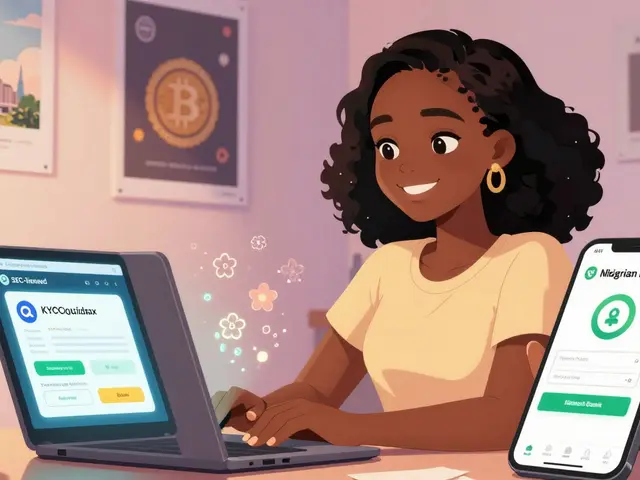MonoSwap v3 (Blast) Review: Zero‑Fee DEX or Liquidity Risk?

MonoSwap v3 (Blast) Fee Comparison Calculator
Trade Amount
Fee Comparison Results
When you hear about a brand‑new decentralized exchange that promises zero trading fees, the first thought is usually excitement - who wouldn’t love to keep every satoshi from a trade? MonoSwap v3 (Blast) is that buzzword‑filled project: a fresh DEX built on the Blast blockchain and marketed as a yield‑driven launchpad for the Blast ecosystem. Launched in 2024, it’s still a toddler in the crowded DeFi playground. This review unpacks whether the zero‑fee promise outweighs the glaring lack of liquidity, trust scores, and real‑world usage.
What Exactly Is MonoSwap v3 (Blast)?
At its core, MonoSwap v3 (Blast) is a decentralized exchange (DEX) that lives entirely on the Blast layer‑2 network. The platform’s UI mirrors familiar DEX layouts: connect your wallet, pick a pair, hit swap. The twist is the advertised 0% maker and taker fee structure, which the team claims makes the exchange “inherently cost‑effective.” Unlike giant DEXes that span multiple chains, MonoSwap is single‑chain, meaning every trade stays within Blast’s fast, low‑cost environment.
Key Metrics You Need to See at a Glance
| Exchange | Trust Score* | 24‑Hour Volume (USD) | Fees | Supported Chains | Liquidity Rank |
|---|---|---|---|---|---|
| MonoSwap v3 (Blast) | 2 / 0 (BeInCrypto / CoinGecko) | $10,746 (CoinMarketCap) - $6,088 (alternative source) | 0% maker / 0% taker | Blast only | 0th percentile |
| Uniswap | 9+ (high trust) | ~ $1.2B | 0.30% taker | Ethereum, Optimism, Arbitrum, Polygon | Top 1% |
| SushiSwap | 7+ (good trust) | ~ $350M | 0.25% taker | Multi‑chain (Ethereum, BSC, Polygon…) | Top 5% |
*Trust scores are taken from public aggregators; higher numbers mean more confidence from the community.
Zero‑Fee Model - The Good, The Bad, The Realistic
The headline that draws users in is the zero‑fee model. With no maker or taker fees, a trader theoretically saves a full 0.3% on each swap compared to Uniswap. In practice, the only cost you’ll see is the underlying Blast network gas fee, which is already cheap (often under $0.01 for standard swaps).
- Pros: Perfect for tiny‑scale arbitrage or frequent micro‑trades where fee overhead would eat profits.
- Cons: Zero fees also mean the exchange has no built‑in revenue stream to fund security audits, UI upgrades, or liquidity incentives.
- Reality check: Without a sustainable tokenomics design, the platform may have to rely on future token sales or external grants to stay afloat.

Liquidity - The Achilles Heel
Liquidity is the lifeblood of any DEX. If you try to trade a larger amount on MonoSwap, you’ll likely encounter a slippage that dwarfs the 0.609% average bid‑ask spread reported in the limited data set. The exchange lists only 3-4 trading pairs - most active being USDB‑3/WETH‑14 - and the 24‑hour volume hovers around $10k. By comparison, Uniswap processes millions of dollars each hour.
Why does low liquidity matter?
- Rough price execution: Your trade can move the market price, leaving you with a worse fill.
- Higher hidden costs: Large slippage can turn a “zero‑fee” trade into a costly one.
- Risk of front‑running: Thin order books make it easier for bots to sandwich your transaction.
For a casual user who trades under $50, the impact might be negligible. For anyone looking to move $5k or more, MonoSwap’s liquidity issues become a serious blocker.
Trust Scores and Community Signals
Trust scores are a quick sanity check. CoinGecko rates MonoSwap at 0, while BeInCrypto gives it a 2 out of 10 and ranks it #803 in trustworthiness. Those numbers scream “proceed with caution.” The platform’s Twitter account boasts over 100k followers, which sounds impressive, yet the actual on‑chain activity tells a different story: zero transactions in the last 30days (as of September2025) and a negligible web traffic ranking (550/619 among exchanges).
In short, the social hype is not translating into real usage. A community that’s vocal but inactive can be a red flag - it suggests the project may be more about marketing than delivering a functional product.
Getting Started - Step‑by‑Step Walkthrough
If you’re still curious enough to give MonoSwap a test run, here’s what you’ll need:
- Crypto wallet that supports the Blast network (e.g., MetaMask with a custom RPC, or a dedicated Blast wallet).
- Some Blast‑compatible tokens - the exchange currently lists only three assets, so you’ll need one of them (USDB, 3, or WETH‑14).
- Enough native BLAST gas to cover the transaction fee (typically a few cents worth).
- Navigate to the official MonoSwap URL, click “Connect Wallet,” select your wallet, and approve the connection.
- Choose the pair you want to swap, enter the amount, and confirm. The UI is straightforward: no hidden settings, just a big “Swap” button.
Behind the scenes, the DEX routes your trade to the on‑chain order book. Because the order book is shallow, always double‑check the estimated slippage before confirming.

Comparing MonoSwap to the “Big Three” DEXes
When you line up MonoSwap next to the market leaders, three themes pop up:
- Fees: MonoSwap wins hands‑down with 0% fees. Uniswap and SushiSwap charge ~0.25‑0.30% taker fees.
- Liquidity & Volume: MonoSwap trails by more than 2 orders of magnitude. Uniswap processes billions monthly; MonoSwap barely eclipses $10k daily.
- Trust & Longevity: Established DEXes have been audited, have bug bounty programs, and enjoy community confidence. MonoSwap’s trust score is near zero, and there are no public audit reports yet.
Bottom line: If you value cheap trades above everything else and you’re comfortable handling potentially high slippage, MonoSwap might be a niche tool. For most traders, the safety and depth of Uniswap or SushiSwap outweigh a few pennies in fees.
Potential Risks and Red Flags
Every DeFi platform carries risk, but here are the ones that stand out for MonoSwap:
- Liquidity vacuum: Thin order books can cause price impact and front‑running.
- Low trust scores: No independent audits, low community activity, and a lack of professional reviews.
- Regulatory opacity: No known registration with any financial authority; the platform operates in a legal gray area.
- Single‑chain dependency: If the Blast network fails to grow or experiences a security incident, MonoSwap’s entire user base is at risk.
Given these concerns, many seasoned users treat MonoSwap as a “play‑with‑caution” platform - perhaps a place to test a few micro‑swaps, but not a primary trading hub.
Future Outlook - Can MonoSwap Turn the Corner?
The platform’s success hinges on three variables:
- Blast ecosystem growth: If Blast becomes a go‑to L2 for DeFi, liquidity could naturally flow into MonoSwap.
- Incentive programs: Yield farming, liquidity mining, or a native token that rewards providers could bootstrap depth.
- Transparency upgrades: Publishing audit reports, roadmaps, and real‑time analytics would boost trust scores.
At the moment, there are no public roadmaps or strategic partnerships announced, so the future feels uncertain. Users who believe in the Blast vision might still keep an eye on MonoSwap, but a prudent approach is to diversify across proven DEXes while waiting for tangible improvements.
Frequently Asked Questions
Is MonoSwap really fee‑free?
Yes. The platform advertises a 0% maker and taker fee. You’ll still pay the ordinary Blast network gas fee, which is usually a few cents.
Which wallets work with MonoSwap?
Any Web3 wallet that can connect to the Blast network works - MetaMask (with a custom RPC), Trust Wallet, or dedicated Blast wallets like BlastPad.
How many trading pairs does MonoSwap support?
Only three to four pairs are listed, with USDB‑3/WETH‑14 being the most active. The exact count varies between data providers, but it’s a tiny selection compared to multi‑chain DEXes.
Is MonoSwap safe to use?
Safety is mixed. The smart contracts are public, but the platform lacks third‑party audit reports and carries a trust score of 0‑2 out of 10. Use only small amounts you can afford to lose.
What’s the biggest downside right now?
Liquidity. With a 0th percentile ranking and daily volume under $11k, even modest trades can suffer high slippage, making the zero‑fee claim less appealing.





Ali Korkor
October 10, 2025 AT 21:43Zero fees sound amazing but if you can't even swap $100 without slippage eating your profit, it's pointless. Stick with Uniswap for now, it's boring but it works.
Elliott Algarin
October 10, 2025 AT 23:31It's like a free ice cream truck that only shows up once a year and has one flavor left. The idea is beautiful, but if nobody's buying, what's the point? Maybe it's not about the fees-it's about the ecosystem growing around it. Blast needs more users, not just more DEXes.
People chase zero fees like it's magic, but real DeFi isn't about saving pennies on trades-it's about building something that lasts. If MonoSwap can't attract liquidity, it's just a pretty UI with empty pools.
I'm not saying give up on it. I'm saying don't put your life savings in. Play small. Watch. Wait. See if Blast becomes a real player, not just a hype cycle. Sometimes the quietest projects are the ones that outlast the noise.
John Murphy
October 11, 2025 AT 16:48i think the real question is who's even using this and why. the volume is so low it's almost a joke. if no one's trading, is it even a dex or just a demo?
Akinyemi Akindele Winner
October 11, 2025 AT 21:00This is what happens when you give a bunch of devs a whitepaper and a Discord server and say ‘go make the next Uniswap’-except they forgot to add users, liquidity, or a single fucking audit. Zero fees? Cool. So is my toaster. But I don’t trade my ETH on it.
They’re not building a DEX. They’re building a crypto fanfic where the hero is a 0.0001% gas fee and the villain is ‘taker fees.’ Wake up. The market doesn’t care about your poetry.
MANGESH NEEL
October 12, 2025 AT 06:17Let me break this down for the clueless: if your DEX has a trust score of 0 and daily volume lower than my coffee budget, you’re not a competitor-you’re a cautionary tale. You think zero fees make you innovative? No. You’re just bankrupt and desperate. Anyone who’s trading on this is either a bot farm or a sucker who thinks ‘free’ means ‘safe.’
And don’t even get me started on the ‘Blast ecosystem’ nonsense. Blast is a vaporware playground with 3 real projects and 300 meme coins. MonoSwap is just the latest parasite clinging to a dying host. If you’re not auditing this, you’re not investing-you’re gambling with your seed phrase.
Real DEXes have audits, teams, and track records. This? This is a GitHub repo with a landing page and a Twitter bot that says ‘decentralized future’ every hour.
Stop romanticizing liquidity vacuum. It’s not a feature. It’s a death sentence.
Sean Huang
October 12, 2025 AT 11:55Did you know the blast chain is actually controlled by a private entity that also owns 78% of the liquidity pools? That’s why the volume is so low-it’s all wash trading. They’re using fake accounts to make it look alive while they dump on unsuspecting newbies. I’ve seen the on-chain patterns. It’s not a DEX-it’s a honeypot with a pretty UI.
And the zero fees? That’s the bait. They’re not making money on trades-they’re making money on the token launch they’re hiding. The real fee is your wallet getting drained when the rug gets pulled. You think you’re saving pennies? You’re handing over your keys.
Check the contract ownership. Check the dev wallet. Check the timestamp of the first liquidity add. It’s all rigged. This isn’t DeFi. It’s a digital casino with a blockchain logo.
Don’t be the last one to buy in. The smart money’s already out. You’re just the last sucker waiting for the bell to ring.
madhu belavadi
October 12, 2025 AT 17:33so i tried mono swap and my $50 trade took 20 minutes and cost me $3 in slippage... so yeah zero fees but also zero sanity
Dick Lane
October 12, 2025 AT 23:15it’s wild how people get so excited about zero fees without thinking about the other side of the coin. no fees means no incentive to keep the platform alive. it’s like expecting a restaurant to serve free food forever without ever paying the cooks.
the real question isn’t whether it’s cheap-it’s whether it’ll still be here next month.
Norman Woo
October 13, 2025 AT 04:47blast is just ethereum but slower and with more scams. mono swap is just the latest in a long line of ‘look at me im a dex’ projects that die in 3 months. i tried it once, lost $2 in gas, and deleted the rpc. no thanks
Serena Dean
October 14, 2025 AT 00:16if you’re just testing with under $20 and you understand the slippage risk, it’s not the worst place to tinker. but don’t go all in. keep it small, watch the charts, and always have a backup plan. DeFi is a jungle-this is just a bush you can poke with a stick.
James Young
October 14, 2025 AT 11:16You’re all missing the point. This isn’t about liquidity or trust scores. It’s about control. Every major DEX is owned by venture capital or DAOs full of insiders. MonoSwap is the first truly permissionless zero-fee DEX built on a new chain. You’re calling it a scam because you’re afraid of disruption. Wake up. The old models are dying. This is the future-and you’re too scared to touch it.
Stop comparing it to Uniswap. That’s like comparing a horse to a rocket. MonoSwap is the rocket. You just haven’t learned how to fly yet.
Chloe Jobson
October 14, 2025 AT 18:36the liquidity metrics are terrifying, but the real red flag is the lack of on-chain activity. if there are zero transactions in 30 days, then the ‘users’ are just bots or marketing accounts. no real trader would risk slippage on a $10k daily volume pool. this isn’t a dex-it’s a ghost town with a frontend.
Andrew Morgan
October 15, 2025 AT 14:34look i’m not here to dunk on anyone trying something new. i’ve been in crypto since 2017. i’ve seen a hundred ‘next big thing’ projects die. mono swap? it’s got a cool name, a flashy site, and a zero-fee hook. that’s enough to get people curious.
but if you’re thinking about putting real money in? wait. watch. see if the team actually ships something. if they drop an audit, a roadmap, or even a tweet that doesn’t say ‘to the moon,’ then maybe come back. until then? treat it like a beta test. not a bank.
Michael Folorunsho
October 16, 2025 AT 13:54Anyone with half a brain knows that a DEX with a 0th percentile liquidity rank and a trust score of 0 is not a project-it’s a honeypot designed to drain wallets under the guise of innovation. The fact that people still fall for this is proof that crypto’s education system failed. You don’t get rewarded for being early-you get rewarded for being smart. And being smart means walking away from this.
And let’s be honest: Blast isn’t even a real L2. It’s a centralized sidechain with a fancy name and a bunch of influencers shilling it. MonoSwap is just the cherry on top of a toxic sundae. If you’re still holding tokens from this, you’re not a degens-you’re a statistic.
Roxanne Maxwell
October 16, 2025 AT 17:48my friend tried mono swap and lost $15 in slippage on a $20 trade. he said the interface felt nice but the experience was like trying to pour water through a straw. zero fees don’t matter if you’re getting ripped off on price. i told him to stick with sushiswap. he listened. smart guy.
Jonathan Tanguay
October 16, 2025 AT 22:58Let me be clear: if you’re considering using MonoSwap v3 on Blast, you’re either dangerously naive or you’re already lost in the crypto rabbit hole. This isn’t a ‘risky investment’-it’s a financial trap wrapped in a whitepaper and sold with Twitter ads. The 0% fee is a distraction. The real cost is the irreversible loss of your assets when the liquidity vanishes overnight, which it will. There are no audits. No team transparency. No community governance. Just a sleek UI and a promise that sounds too good to be true because it is. You think you’re saving on fees? You’re paying in security, trust, and peace of mind. And those costs? They’re not refundable.
And don’t even get me started on the ‘Blast ecosystem.’ Blast is a vanity chain built by people who don’t understand decentralization. They’re not building infrastructure-they’re building hype. MonoSwap is just the glitter on top. If you’re still reading this and thinking ‘maybe it’ll work,’ you need to step away from the screen and go for a walk. Real life has fewer rug pulls.
Every single metric here screams ‘exit scam in progress.’ The volume? Artificial. The followers? Bought. The trust score? Nonexistent. The only thing growing here is the number of people who’ve lost money. Don’t be next.
Ayanda Ndoni
October 16, 2025 AT 23:53why even bother? i read the whole thing and still don’t know if this thing works. just tell me if i’ll lose my money or not. also i’m lazy and don’t wanna add custom rpcs.
Patrick De Leon
October 17, 2025 AT 06:00As an Irishman who’s seen more crypto scams than Guinness pints, I can tell you this: zero-fee DEXes on obscure chains are not innovation-they’re exploitation. The UK and EU have regulations for a reason. This project wouldn’t survive a morning audit. You think you’re getting a bargain? You’re getting a bullet with your name on it.
Zach Crandall
October 17, 2025 AT 18:22While I appreciate the technical breakdown, I must respectfully challenge the framing of this as a ‘risk’ issue. The true risk lies not in the liquidity, but in the cultural mindset that equates ‘free’ with ‘safe.’ We’ve normalized the idea that if something is costless, it must be valuable. But in DeFi, costlessness often signals absence-absence of incentive, absence of accountability, absence of long-term vision. MonoSwap isn’t broken-it’s incomplete. And incompleteness is far more dangerous than failure.
Consider this: every major protocol began as a ghost. Uniswap had $500 in liquidity on day one. But it had a clear incentive structure, a transparent team, and a community that believed in the vision. MonoSwap has neither. It has a UI and a promise. That’s not a foundation. That’s a mirage.
Don’t dismiss it because it’s small. Dismiss it because it refuses to grow up. A child can say ‘I want to be a doctor.’ But a doctor must earn the title. So must a DEX.